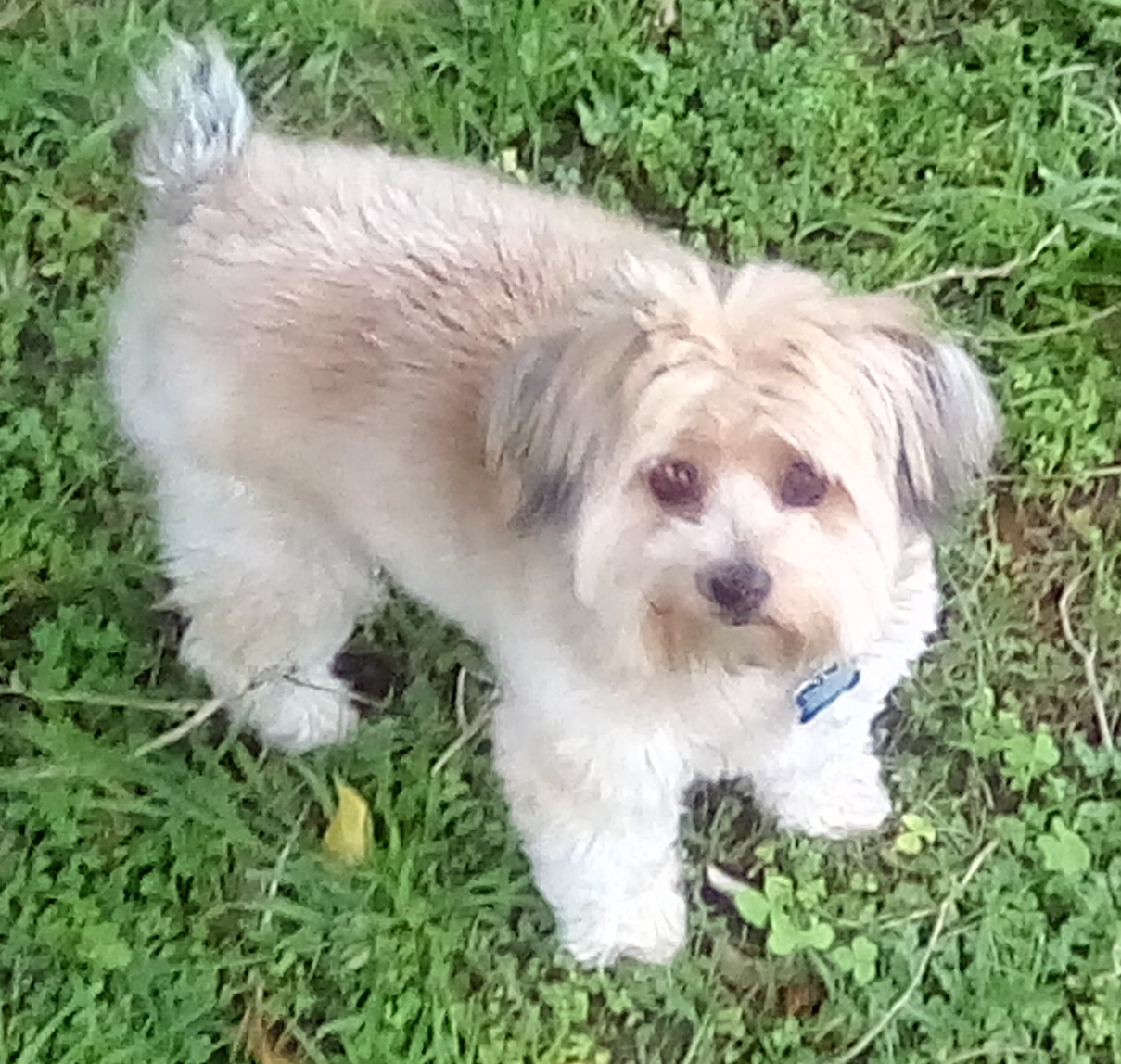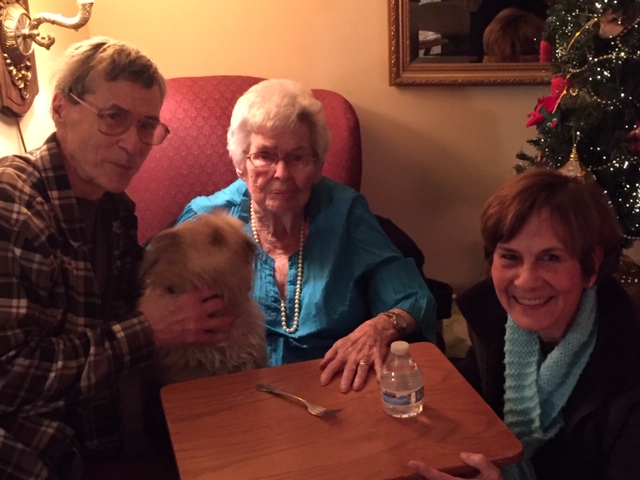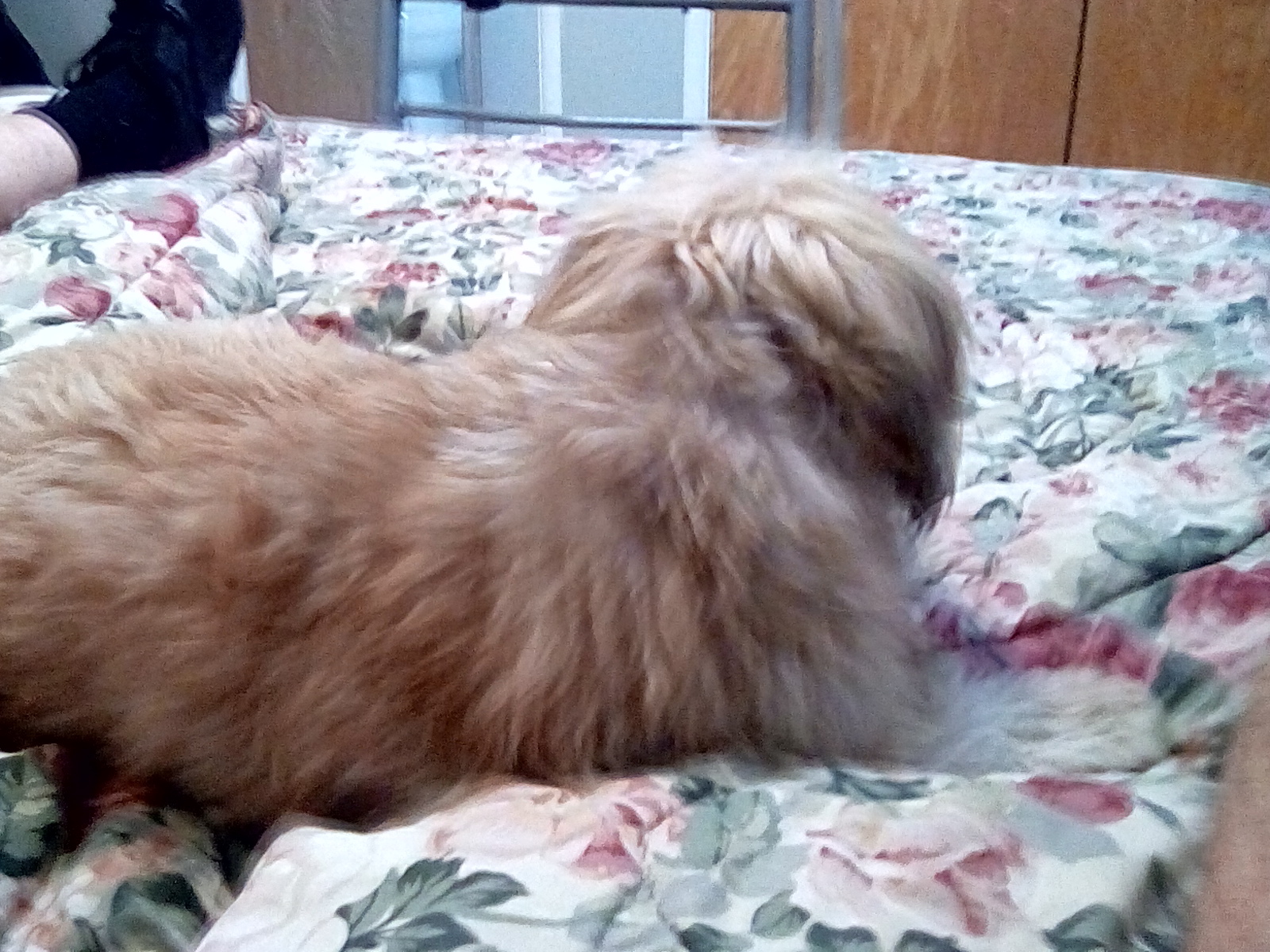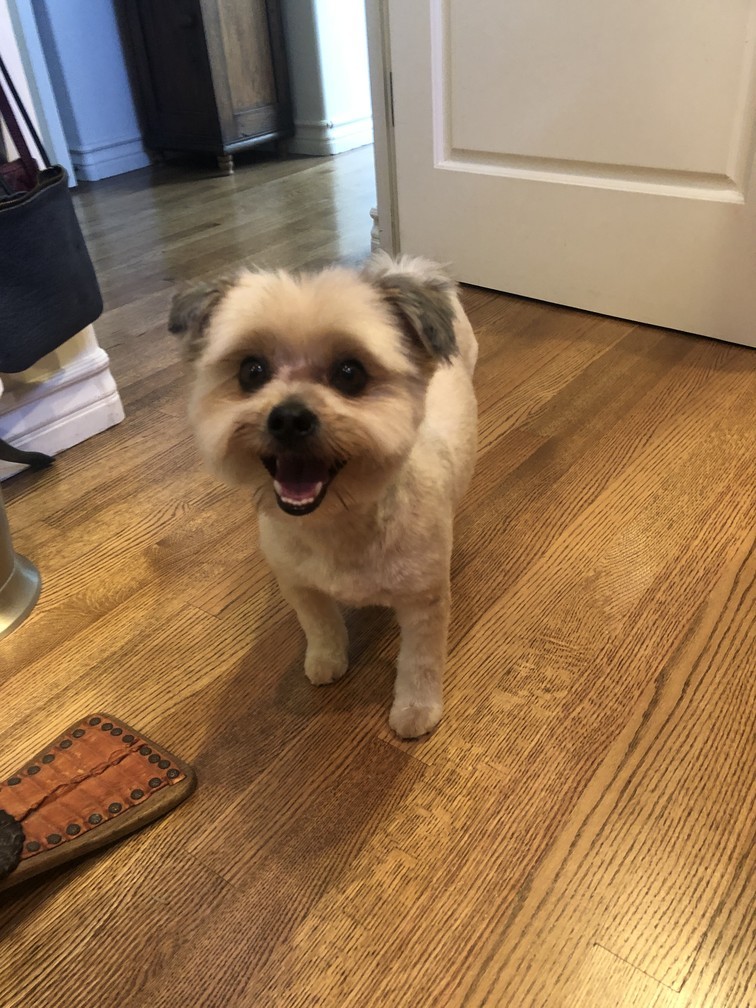finding a good home for Zoe — Part 2

This page has “more about Zoe” — and her life with us (Mom & me) and now with me — to supplement my short page about her.
I've included lots of information in these pages (especially this one) for people like myself, who want to “get information first, then make a decision.” When I was looking for a dog in late 2018, I was frustrated because “the history was a mystery” for almost every dog, so I wondered “why is this dog in the shelter?” — is it for some kind of “bad dog” reason? and of the many possible reasons, which one? — and “what will she REALLY be like when she is out of the shelter (lonely prison) and living in our house?” To help you answer your questions now, I want to help you know more about Zoe so you can make an informed decision. My short page about "finding a good home for Zoe" summarizes the most important thing you should know: Why do I want to let her go? It isn't for any “bad dog” reason. She is a “good dog” and if I wasn't moving away, I wouldn't be giving her away.
letting Zoe go before I move to the Midwest: In 2018 after the death of our beloved dog Kobe (who looked like Toto from Kansas/Oz, and danced with joy twice each day), Mom and I got a new dog for her. It wasn't for me. Although I always have loved dogs,* and (except for short times between dogs) there always was a dog in our family's home, during my 40 years of living away from Anaheim I never had a dog. And while Mom and I were looking for a dog, before getting Zoe in November 2018, my plan was to eventually find a good home for our dog (who has become my dog) instead of taking her with me when I again move away from Anaheim. You can see more of our story — written (while we were trying to find a dog) for people in dog-rescue organizations, to explain why "even if we won't keep your dog for the rest of her life in a Forever Home, we can give her a loving time of Long-Term Foster Caring, so when she leaves us she will be feeling & behaving better than when we got her" — in this page. / * So most years I attended the annual Dog Jog in Madison, to be with dogs and talk with their people. {Dog Jog info [on page 5] and photos}
Everything in this page is optional reading. You can look at paragraph titles, and read whatever looks interesting. If any parts of it are “too much” (are “more than you want to know” or if you want to know other things) you can contact me – Craig Rusbult <craigru57-att-yahoooo-daut-caum> – with any questions you have. And maybe we'll have enough mutual interest that we'll want to arrange a meeting of Zoe with all of you, and of course this — especially if you have a dog and we want to know if the dogs will get along well — can be the most useful way to get information.
Honesty: I'm trying to give you thorough-and-accurate knowledge about Zoe. I'm hoping you will give me thorough-and-accurate knowledge about your situation, because I'm trying to find a GOOD home for her, so honesty (from all of us) is essential.
Visiting: I would like to see Zoe again, mainly to reduce her feelings that “I've been abandoned AGAIN.” This time it won't be like 18 months ago when she was captured as a stray (she wasn't an owner-surrender) and was put into the shelter for a week, in a room with three other dogs, surrounded by many other rooms filled with loudly barking small dogs. But even though she will be going to a good home with loving people (and hopefully a dog buddy), Zoe and I love each other and we will miss each other. Although I will understand the reason for separation (and in fact will be causing it), she won't understand. But at least I want her to know that even though she won't be staying with me, she has not been forgotten, and I still love her. This is how I feel, but... / You will make all decisions about IF (and WHEN) you think it's wise for me to visit, because when she's in your home (after I've decided you're the best new home for her) you will be her new owner. You can observe how she is adjusting, and think about what is best for her. If you want, we can discuss the pros & cons of visiting, and timing. But you will make the decisions, and if you say “no visits” that's how it will be. / timing of visiting: If I had a Time Machine with Life Editing (using Control-Z for Undo-Redo) I would begin the process of “finding a good home for Zoe” in early February instead of early May, so before my first visit there would be more time for her to get comfortable in feeling “this is my new home, and they love me, and I like it here.” And we could arrange for several visits, spaced apart in time. But in reality I probably will be leaving for the midwest sometime in late June, so there is a limited amount of available time. {also, later I'll occasionally return to visit my sister [who lives in Huntington Beach] and enjoy SoCal, and probably to attend a conference in July 2021.}
Naming: If you want to give Zoe a new name, of course that's fine with me, because she then will be your dog. And web-pages say a dog will soon learn its new name.
Although this paragraph has been moved into the main page, you may want to read it again.
Zoe is a Facilitator of Joy: In her attitude and actions, Zoe can help us be more joyful. During the 4 months when we visited Mom almost daily in a living facility, Zoe would meet many people and would greet them with enthusiastic joy; most people would respond joyfully to her; then when they interacted with me, their joy (due to Zoe) would help our interactions be more joyful and better, because all of us (Zoe, them, me) were in a joyful mood. In this way, Zoe was a facilitator of joy. A friend from church said “Zoe is a good role model for attitudes-and-actions we all should have, joyfully celebrating life, enthusiastically sharing our joy with others.” {although with Zoe the enthusiasm is obvious, during our person-to-person interactions the enthusiastic joy is usually expressed in ways that are more subtle, but are real, and can be recognized by others.}
Zoe with Children: Basically, she is fascinated by them. I think she would behave well with children, and they would have plenty of joyful fun together. But (as with dogs) "I don't have enough experience to know." Based on my experiences with her, I'm confident that she would not bite them, would not hurt them intentionally. But with small children she might hurt them accidentally. How? When she meets small children during a walk, she tends to jump around, and I control her movements (by stepping on her leash to shorten it) so she doesn't accidentally “head butt” them. Again, as with other over-enthusiastic greetings, I think she can be trained to behave more gently with children, but I haven't given her enough experiences-and-training to do this. / my semi-success: When she greets me every morning, and occasionally when I return home from an errand, she has enthusiastic greeting-emotions, but her greeting-actions are controlled because I've showed her that “when four paws are on the ground, you get affection.” Probably she also would learn this principle-of-behavior when she interacts with children, but I haven't given her enough experience with them to know.
Zoe with Other Dogs: In the semi-short page I said "an ideal situation might be... kids plus father & mother, and probably a dog." Why "probably" instead of certainly? Because I think Zoe would get along well (probably really well) with another dog in the home, but I don't have enough experience to know. And of course it would depend on the situation; even if she would do well with most dogs, it might not work out with the particular dog already in your home. Or, more likely I think, it could be great for both of them, satisfying and fun. / Here are some observations of Zoe in a variety of situations: She is fascinated by other dogs, and is generally friendly and eager to meet them. When we visit a dog park and she is free to roam off-leash, she is lively but relaxed, gets along well with all other dogs (i.e., I've never seen any hostilities begun by her or them) and it's a fun time for her. On a leash while walking in the neighborhood, when she meets another dog she is alert and intense, giving mixed doggie-signals (always tail wagging, but often also mellow growling & soft barking). There are some dogs behind gates, and she is good buddies with two of them: a medium-small female, and large male. Like her interactions with people — when meeting them she has high energy, but soon becomes relaxed and mellow — with another dog I think she would be relaxed during most of their time together. / So overall her dog-interactions are mostly positive, but with some negative. And with uncertainties. I think another dog in the home (especially if it's a similar size) would be more like a free-to-roam dog park where Zoe's interactions have been all positive; but of course a wider variety of dog-dynamics would occur in a long-term relationship between dogs. If a potential new home includes another dog (as I'm hoping it will), all of us together would figure out a where-and-how “strategy for letting them meet” and then watch what happens; then we can discuss things, trying to imagine how the dogs would think/feel/behave during long-term living together.
Walks: Zoe gets excited when I say “let's go for a walk” and then, because it's her adventure, I let her decide where she wants to go, although with occasional guiding (saying “no” and “this way” while pulling on her leash) to shape our overall journey, or to hasten its conclusion by suggesting “let's go home, get treats and food.” She wants to trot at the beginning of our walk (and later when I'm urging her on, saying “let's run”) and occasionally (like when she's motivated by seeing a cat) she sprints; but usually her pace is a brisk walk (when she wants to make progress) or slow walking (when she wants to sniff the odors or just meander); she leads us thru our neighborhood, and usually to nearby hotels (we live near Disneyland) or neighborhoods. For almost a year we did twice-a-day walks, but for the past few months I've been feeling time-stressed (due to coping with the HUGE project of emptying our parents' house, trying to "give away more so I can throw away less") and it's usually been only once-a-day, so if you go once she will think this is ok (it's “the usual”), and if you go twice she will enjoy both times. {as you've probably figured out, some of my common words-for-Zoe are in bold}
Car Rides: She gets excited when I ask her “do you want to go bye-bye?” (in my car) with an enthusiastic “yes” as her answer. And when we stop she wants to walk, to enjoy the adventure of exploring a new area.
Barking: Although small dogs tend to bark a lot, usually she is fairly quiet. But not always. In some situations she does bark, but usually it's for only a short time because she knows what "quiet" means, and she wants to please her master. (whether it's me now, or you later)
Greeting: When we got Zoe she was an over-enthusiastic greeter, and she still is. She is a little better now, but still not well controlled. I'm confident that she can be trained to retain her joyful enthusiasm AND control her behavior, and so far I've been semi-successful in doing this. I think most of my failure (so the success is only "semi") has been due to my lack of consistency; when greeting new people, I haven't consistently enforced the principle that “if four paws on ground, then you get attention & affection,” mostly because my mother couldn't bend down to the level of Zoe, so standing up with her paws on Mom's legs was the best way they could interact, so they both liked this; it was similar with people she met during a walk or in Mom's living facility, because most people didn't want to “bend down” to greet her, or (especially at the facility) they couldn't do this. {the situations were similar whether she met people during a walk (they didn't want to bend down to pet her) or met people in the facilities where Mom was living her final 4 months} Zoe does want to please (as in my much more successful training with "be quiet") and I think she could become an enthusiatic-yet-controlled greeter if your training is better than mine, is more consistently applied.
Sleeping: During the first 8 months in our home, Zoe liked to sleep in Mom's bed, on the other side or at the foot (she didn't try to lay on top of Mom, she just wanted to be nearby). Then after Mom moved out, Zoe began sleeping in a separate room because I'm a light sleeper and didn't want her movements to wake me. / the bottom line: Zoe's preference is to sleep with a person in their bed, or (second choice) in her doggie bed in the same room, but sleeping in another room is fine with her. She has done all three, and seems ok with all, so you can decide where you want her to be during your sleeping times.
Eating: One of Zoe’s favorite "simple pleasures" is food. She is an omnivore (like a bear, a species-cousin of dogs) who enjoys a wide variety of foods, especially meats and sweets. I feed her a wide variety, but if you want to simplify she would be fine (for enjoyment & nutrition) with only canned dog food, and maybe some other things, or even dry dog food (although she doesn't eat it now, if it's all she had I think she would eat it and learn to enjoy it). / Her regular "wide variety" food includes: two kinds of canned dog food (with vitamins & minerals), Blue Buffalo (the main bulk of her diet) and Cesar; cooked meats (hamburger, chicken) and canned meats (tuna, salmon, sardines, chicken), and the part of a boiled egg (a little white, half of the yolk) that I don't eat; also small amounts of other things, like... peanuts; oils (a capsule of fish oil, plus 1/4 teaspoon of olive oil on a little bit of boiled barley-rice-lentils that's one of my own main foods); fruits (orange, apple, but no grapes because they're bad for dogs) and frozen berries (blue, straw, black, rasp). But if you want to simplify, she would be fine (for enjoyment & nutrition) with only the canned dog food, and maybe some of the other things, or even with dried food (although she doesn't like it much now, if it's all she had she would eat it and learn to enjoy it). / limited variety: When wondering "should I feed her this new kind of food?" I check web-pages to see if it's safe & nutritious for dogs, and if its amount should be limited. / a bonus: I now have lots of extra food — cooked hamburger, dog food (Blue Buffalo, Cesars), fish oil capsules — that can go with her to her new home.
Her Fur: She is light brown with a little gold (Mom said she is “honey colored”) ans some dark-area highlighting. I've never noticed any shedding. In winter we've let her fur grow long and fluffy, but in summertime with shorter hair (so she looks smaller and less fluffy, but still pretty) she is cooler and thus more comfortable.
DNA Testing: What is Zoe? Two testing companies (Embark & Wisdom Panel)* agree that she is roughly half Yorkshire Terrier and half Pomeranian. This surprised me for two reasons. First, before seeing the results I would have predicted that she was mostly Norfolk Terrier. Why? In mid-November 2018, Mom and I got Zoe from a shelter, where she arrived as a “stray” (not a “surrender by owner”) so her history is a mystery. A week later, on Thanksgiving Day we watched a  National Dog Show on TV, and the Norfolk Terrier (as in photo at right) looked a lot like Zoe, so I thought “that's what she is” but mixed with some Shih Tzu to make her “fluffy” and a little bit larger, and maybe something else (like Welsh Corgi, Brazilian Terrier, or Jack Russell?) to give her a naturally bobbed tail; also, Zoe's ears look dropped (like Norfolk) but Yorkie & Pom have pricked ears. A second reason was that her healthy weight (14-15 pounds) is more than either pure breed (both averaging 7 pounds) in a Yorkie-Pom, and it's more than the 9 pounds predicted by Embark based on the specific size-regulating genes they found in Zoe's genome.
National Dog Show on TV, and the Norfolk Terrier (as in photo at right) looked a lot like Zoe, so I thought “that's what she is” but mixed with some Shih Tzu to make her “fluffy” and a little bit larger, and maybe something else (like Welsh Corgi, Brazilian Terrier, or Jack Russell?) to give her a naturally bobbed tail; also, Zoe's ears look dropped (like Norfolk) but Yorkie & Pom have pricked ears. A second reason was that her healthy weight (14-15 pounds) is more than either pure breed (both averaging 7 pounds) in a Yorkie-Pom, and it's more than the 9 pounds predicted by Embark based on the specific size-regulating genes they found in Zoe's genome.
* Why two tests? I was suspicious of the first test (done by Embark in December 2018) because she had no Norfolk Terrier, and she was unexpectedly large, and because I had asked our vet (when we were there for vaccinations) to take the saliva sample, so I wondered whether she “gave the technician a hard time” so they decided to make their job easier by just getting a sample from another small dog who was more docile. I wanted to be confident, so later I took a saliva sample myself and got “a second opinion” from Wisdom Panel who said 50% Yorkshire and 50% Pomeranian, agreeing with Embark who gave more detail: 50% Pomeranian and 47% Terrier (36% Yorkshire, 11% closely-related Biewer Terrier), plus 3% Maltese. If you want to know more of Embark's info about Zoe — re: the disease genes they checked (all ok for her), and her many close relatives (so far all are “first cousins” who share 1/8 of her genes, all on the Yorkie side of her family tree) to solve the mystery of her history, and more — I can give you the password-for-Zoe on their comprehensive website. But her relatively higher weight, compared with both purebreds, remains a mystery. One wrong-answer is saying “she is overweight.” No, she is close to her ideal weight (not much under or over) even though she tends to “look fat” when her fur is long, sort of like when a woman asks “does this dress make me look fat?” (see the two fluffy-and-cool comparisons below) and with Zoe's fur coat the honest answer is “well, yes.” :<)
If you have questions or want to talk about anything,
you can contact me, Craig Rusbult - craigru57-att-yahoooo-daut-caum.
| Zoe with me and Mom and Sherry (another cousin, older sister of Phil). |
|
|
 |
|
|
| |
|
|
| before and after: a fluffy doggy becomes a |
|
cool doggy after her summer haircut. |
 |
|
 |
| |
|
|
Zoe in her new home, in our back yard, |
|
Zoe in her New Home: bright-eyed & alert, |
 |
|
 |
| |
|
|
| |
|
|
| |
|
|
| |
|
|
| |
|
|
| |
|
|
| |
|
|
| |
|
|
| |
|
|
| |
|
|
| |
|
|
| |
|
|
| |
|
|
| |
|
|
 National Dog Show on TV, and the Norfolk Terrier (as in photo at right) looked a lot like Zoe, so I thought “that's what she is” but mixed with some Shih Tzu to make her “fluffy” and a little bit larger, and maybe something else (like Welsh Corgi, Brazilian Terrier, or Jack Russell?) to give her a naturally bobbed tail; also, Zoe's ears look dropped (like Norfolk) but Yorkie & Pom have pricked ears. A second reason was that her healthy weight (14-15 pounds) is more than either pure breed (both averaging 7 pounds) in a Yorkie-Pom, and it's more than the 9 pounds predicted by Embark based on the specific size-regulating genes they found in Zoe's genome.
National Dog Show on TV, and the Norfolk Terrier (as in photo at right) looked a lot like Zoe, so I thought “that's what she is” but mixed with some Shih Tzu to make her “fluffy” and a little bit larger, and maybe something else (like Welsh Corgi, Brazilian Terrier, or Jack Russell?) to give her a naturally bobbed tail; also, Zoe's ears look dropped (like Norfolk) but Yorkie & Pom have pricked ears. A second reason was that her healthy weight (14-15 pounds) is more than either pure breed (both averaging 7 pounds) in a Yorkie-Pom, and it's more than the 9 pounds predicted by Embark based on the specific size-regulating genes they found in Zoe's genome.

